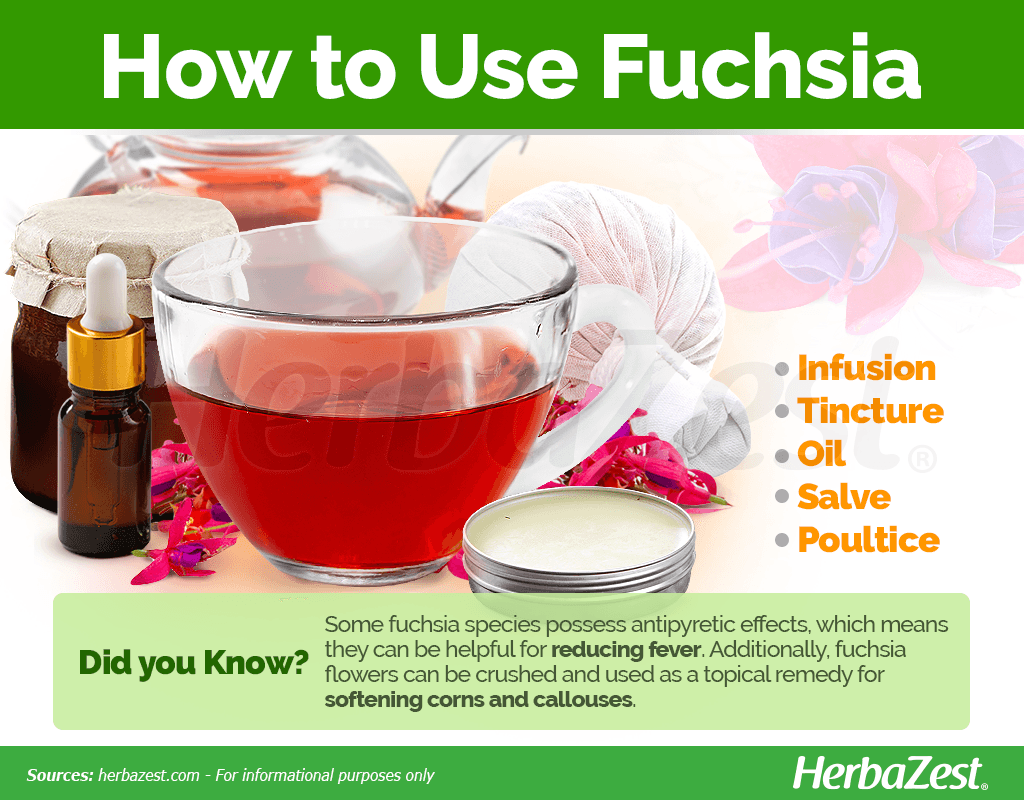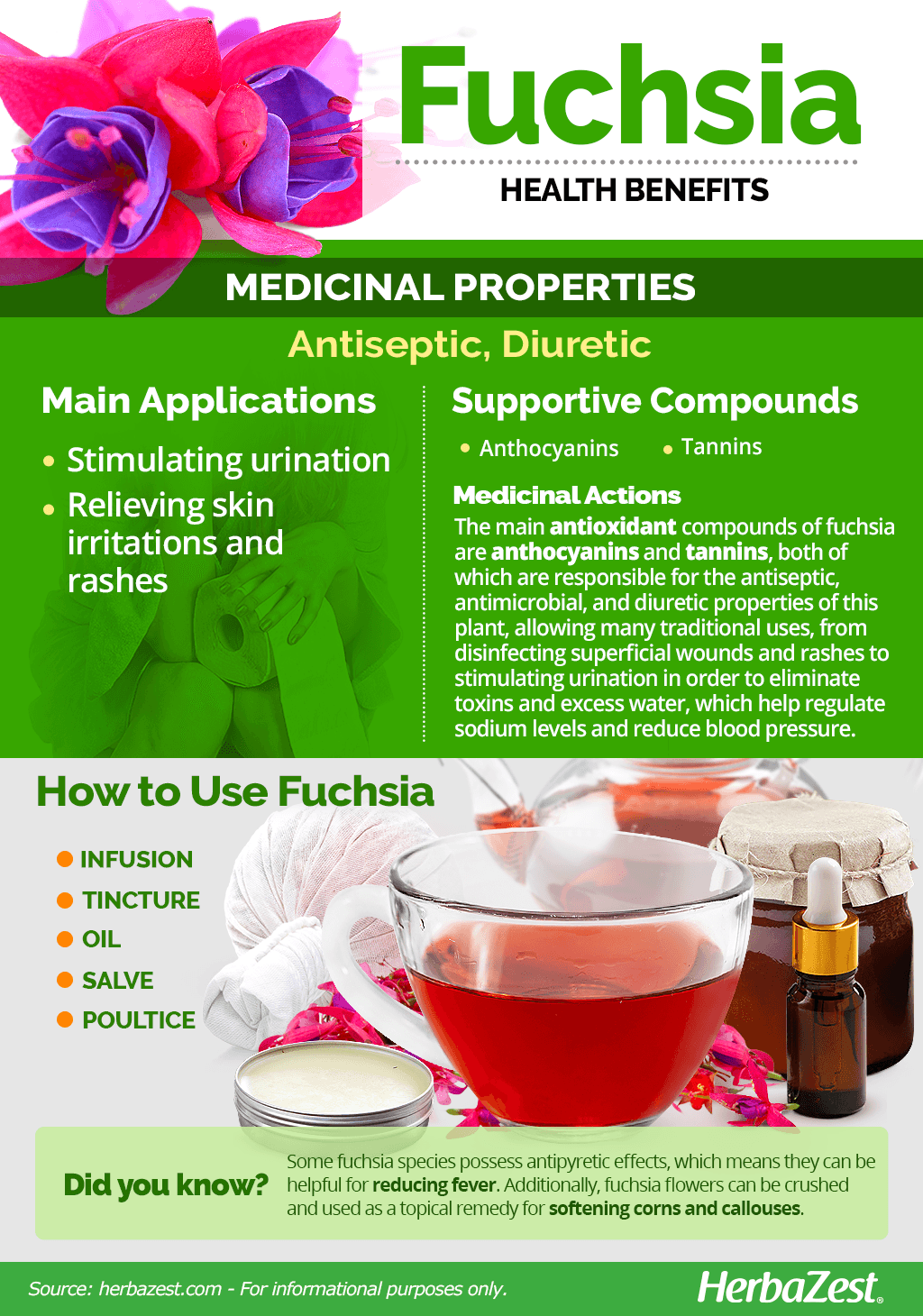Fuchsia Medicinal Properties
Health Benefits of Fuchsia Berry
Some ancient South American cultures, as well as the Maori in New Zealand, developed various health treatments using the elements of the fuchsia plant. Scientific studies have since taken place, revealing that the plant does have medicinal properties that can be utilized in a range of ways. Based on traditional uses, the health benefits of fuchsia include:
Stimulating urination. The plant contains a diuretic substance, which encourages increased urinary production. This helps to eliminate excess of water and toxins, as well as reduce sodium levels and lower blood pressure.
Relieving skin irritations and rashes. It is said that the juice exuded from the plant can be used as a treatment for skin ailments, such as blisters and rashes, as well as for staving off itching.
Treating fevers. Some fuchsia species have antipyretic effects, which means they can help lower body temperature and, therefore, help people withstand fever.
In some rural parts of Scotland, people use crushed fuchsia flowers as a remedy for corns and callouses. The mixture is applied to the area and wrapped to secure it to the foot all day.
How It Works
The fuchsia plant contains antioxidants, which the human body needs in order to combat cellular decay, prevent degenerative illnesses, and resist the effects of pollutants. Among these compounds, scientific research has revealed that two anthocyanins - cyanidin-3-glucoside and cyanidin-3-galloylglucoside - are responsible for the antioxidant properties of fuchsia.1,2
The accumulation of salt in the body can cause fluids to build up in blood vessels, which, in turn, can raise blood pressure. The active compounds that cause fuchsia's diuretic and antimicrobial effects are related to tannins, which help the kidneys eliminate salt and water through urination.3
Other herbs with diuretic properties are artichoke, asparagus and horsetail, whereas similar antiseptic, antimicrobial benefits can be obtained from calendula, cardamom, echinacea, and lavender.
Fuchsia Berry Side Effects
Fuchsia is not thought to have any serious side effects, and it can be used topically or taken orally. As with any health supplement, it is advised to seek advice from a health professional before regular consumption, particularly for women who are pregnant or breastfeeding.
Fuchsia Berry Cautions
If picking the plant straight from the garden, care should be taken to wash it and sanitize it thoroughly before consumption. It is common for bugs and fertilizer residues to collect in the folds of the petals and leaves. These can be harmful to the human body.
- Medicinal action Antiseptic, Diuretic
- Key constituents Anthocyanins, tannins
- Ways to use Hot infusions/tisanes, Tincture, Poultice
- Medicinal rating (2) Minorly useful plant
- Safety ranking Safe

How to Consume Fuchsia
There is a range of recipes available that use the different parts of the fuchsia plant. Fuchsia berries vary in flavor, from very bitter to pleasant and sweet, and can be consumed raw or cooked. It is generally thought that the darker the berry, the sweeter its flavor. Some varieties are said to emit a peppery aftertaste. Generally, the berries are most tender during the early part of the season.
They can be frozen and used when desired to make jams, jellies, and fruit chutneys. Also, they can be added to cakes, muffins, brownies, and other dessert recipes.
The best form to take advantage of the medicinal properties of fuchsia is through herbal remedies, which are relatively simple to buy or make at home.
Herbal Remedies & Supplements
These preparations can be made from the roots, stalks, leaves, flowers, and berries of the fuchsia plant. Some can be taken orally and others are for external use only. It is suggested that the easiest way to source the preparations is to simply make them at home using fuchsia that has been grown locally.
Tea. An infusion can be made from fuchsia flowers, leaves, and berries. Whether they are fresh or dried, let them steep in hot water for around five minutes.
Tincture. This preparation is a good option for fast consumption of the herb. A tincture is a concentrated form and should be diluted with water.
Oil. The different components of the plant can be infused with oil for topical use. Not only will this soothe any skin irritations, but it will also moisturize the skin effectively.
Salve. A salve made from fuchsia is a popular preparation to be used on rashes and other skin ailments. It is useful for calming itchy and inflamed skin.
Poultice. Traditionally made from the crushed fuchsia flowers and petals, it can be wrapped in gauze and be placed on the skin to treat blisters, rashes, and other external problems.
- Edible parts Flowers, Fruit, Leaves, Root, Stem
- Edible uses Coloring, Beverage

Growing
Although native to warm climes, the fuchsia plant can thrive in a variety of conditions. It is possible to obtain cuttings from existing plants to grow new plants. Cultivating fuschia requires some maintenance, but if guidance is followed, the rewards are great.
Growing Guidelines
The base of the stem should be planted about two inches (5 cm) below the surface of the soil.
All varieties of fuchsia prefer semi to full shade.
The fuchsia plant require generous watering twice a week and need to be kept in moist but well-drained soil.
The plant should be pruned right back in early spring.
- The fuchsia flower blooms from early summer to the end of fall.
- Generally, fuchsia varieties with smaller leaves and flowers are hardier.
- Fuchsia prefers USDA hardiness zones 5 - 7.
- Life cycle Annual
- Harvested parts Flowers, Roots, Leaves, Stem, Fruit
- Light requirements Partial shade
- Soil Well-drained
- Growing habitat Cool temperate regions
- USDA Plant Hardiness Zones 5a, 5b, 6a, 6b, 7a, 7b
- Planting time Spring
- Plant spacing average 0.15 m (0.49 ft)
- Potential insect pests Aphids, Leafhoppers, Mites, Thrips, Whitefly, Flea beetles
- Potential diseases Rust
- Potential animal pests Birds, Rodents
Additional Information
Plant Biology
Fuchsia plants can be evergreen or deciduous shrubs and vines, producing vibrant flowers from the summer to fall. The plant can grow 4 - 10 feet (1.2 - 3.0 m) tall and nearly as wide, and it bears oval, green leaves that range in length of one to three inches (2.5 - 7.6 cm), arranged in an opposite fashion. The flowers and berries grow to hang down from the individual branches. The fuchsia flower is typically bright pink or purple, with around five long, pointed petals around the outside and a formation of darker petals in a closed cup inside those. Protruding from within the inner layer of petals are a number of very thin petals. The appearance of this combination has led to people comparing the flowers to dangling Christmas decorations.
Classification
The fuchsia plant (Fuchsia spp.) is part of the Onagraceae family, which consists of 12 genera. This group is more commonly labelled the evening primrose family, and there are over 700 accepted species within it, including the well-known evening primrose flower, genus name Oenothera.
Related Species and Varieties of Fuchsia
The number of species within the genus Fuchsia is disputed. It is thought that all but three of them originate from South America, and the other three are from New Zealand. One New Zealand species - F. excorticata - is known in Maori tradition as kotukutuku, a word used as a verb in their vocabulary to mean “to be the size of a fuchsia berry.”
Historical Information
The name fuchsia was assigned by Charles Pumier, a French plant enthusiast who discovered the flower in Mexico in 1690. He decided to name it after an admired German botanist, Leonard Fuchs. It is said that an English sailor, Captain Firth, brought some of the plants back to the Royal Botanical Gardens at Kew, in London, from a journey to South America in 1788. Soon after this time, cultivation of the plant became increasingly popular in England.
Popular Beliefs
Some South Americans believe that eating the flowers and berries of the fuchsia plant can cure depression, giving reason for a traditional colloquial name, corazon corazon, which translates to “heart heart.”
Some alternative health practitioners believe that fuchsia can help people to accept the problems of their past and enable them to move forward by “balancing the hemispheres of the brain.”
Other Uses
Dye. Both the petals of the flower and the wood of the stem can be used to make rich dyes.
Cosmetic industry. Fuchsia compunds are often used in the world of cosmetics, in the production of soaps, creams, and bath products.
Gardening. The colorful fuchsia flower is very attractive to hummingbirds and other pollinators, and it can draw them to a garden.
Decoration. The flowers of fuchsia can also be used to make potpourri, since the vibrant color of the petals make it an attractive addition to a medley of other dried flowers.
Fuchsia is easily cultivated, and it is valued by many as an aesthetic feature of a garden. The edible berries and flowers possess medicinal properties that can be beneficial to human health, and it is relatively simple to gain these by consuming the plant either in its raw, natural form or as a supplement.
- Other uses Cosmetics, Dye, Perfume, Soapmaking
Sources
- Blood Pressure UK, Diuretics – blood pressure medication
- Botanic Gardens Conservation International, The Roots of Wellbeing
- Edible & Medicinal Flowers, pp. 36
- Making the Most of Shade, pp. 245
- Maori Dictionary, kotukutuku
- Plants For A Future, Fuchsia magellanica - Lam
- The British Fuchsia Society, History of Fuchsias
- The Garden Forager: Edible Delights in your Own Back Yard
- The Horticulture Gardener's Guides, Shrubs, pp. 68
- The Plant List, Onagraceae
- Victoria University of Wellington,, New Zealand Plants and Their Story, The Native Fuchsia
- Washington State University, Hardy Fuchsia
- Royal Horticultural Society, Fuchsia magellanica, lady's eardrops
- Pharmacognosy Reviews, Role of natural herbs in the treatment of hypertension, 2011
Footnotes
- Acta Bioloica Hungarica. (2016). Examination of secondary metabolites and antioxidant capacity of Anthyllis vulneraria, Fuchsia sp., Galium mollugo and Veronica beccabunga. Retrieved March 24, 2023, from: https://pubmed.ncbi.nlm.nih.gov/28000504/
- Natural product communications. (2011). Anthocyanins from Fuchsia flowers. Retrieved March 24, 2023, from: https://pubmed.ncbi.nlm.nih.gov/21366041/
- Phytotherapy Research. (1994). Hypotensive and diuretic effect of Equisetum bogotense and Fuchsia magellanica and micropropagation of E. bogotense. Retrieved March 24, 2023, from: https://onlinelibrary.wiley.com/doi/abs/10.1002/ptr.2650080308






